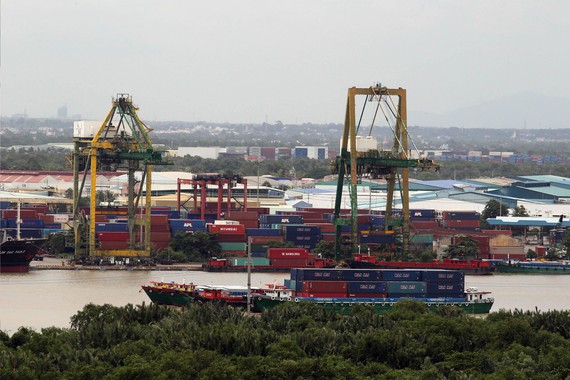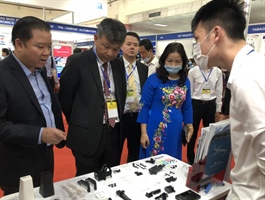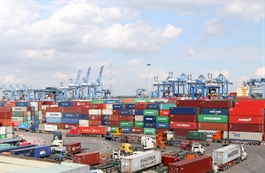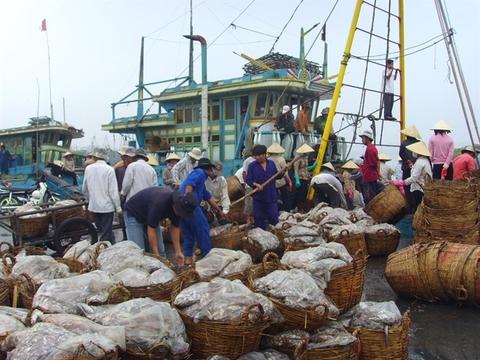Vietnam will gain from strong logistics industry
Vietnam will gain from strong logistics industry
The logistics industry can easily become a much needed source of strength for Vietnam to compete with other countries in the region, but it is necessary to build a solid comprehensive foundation first.
Illustrative photo.
|
The key lies in locating the true value of the logistics industry in relation to Vietnam's position as compared to other neighboring countries in the region and the world, and then build on appropriate strengths and competitive strategies.
Ground reality
Vietnam has great potential for becoming a seafaring nation because of its long and lengthy coastline and advantageous location. In particular, the Central Key Economic Region that stretches along a coastline of 609 kms offers an important advantage for socio-economic development and simultaneously ensures national defence security for the entire central coastal region. Vietnam has important seaports in that area such as Chan May, Tien Sa, Ky Ha, Dung Quat and Quy Nhon, and also international airports, national railway networks, and broad roads leading towards many economic corridors. These are important prerequisites for the development of logistics facilities and the building of logistics centers.
Unfortunately, the current seaport system is in a state of neglect. In the past we have been attracting investments for seaports in segments. A seaport of more than ten hectares had up to five to six investors, and each investor held a few hectares but did not invest in a seaport. The story of Tien Sa port in Da Nang is a typical example. With the location and existing infrastructure conditions being newly expanded for investment, Tien Sa is well located and very convenient to develop as a deep-water seaport, but there has been no proper attention given to its planning, right from the very beginning. Authorities allowed several real estate investors to jump in and take possession of large areas of land who then turned Tien Sa port into a tourist area. Then, they started on a plan to build Lien Chieu port next to Chan May port, by pouring huge investment amounts in dredging, building bridges, and embankments, which cost nearly VND 35,000 bn.
When examining the area which is planned to be the new Lien Chieu port and a Class-1 logistics center in Hoa Nhon commune on about 20 hectares, we can clearly find shortcomings in planning and investment in the construction of its infrastructure. Although the plan is to build a Class-1 logistics center, the total investment is nearly VND 15,000 bn, but the area is only about 20ha. Once the area is fully cleared we will be left with not much land space to build a Class-1 logistics center. As per Planning 1012/QD/TTg phase 2, the area must be more than 70ha. In addition, the prospect of goods shipped to and via Da Nang port from the East-West economic corridor or from the central economic regions is not realistic in terms of location and investment. Elsewhere in the world, the plan for a regional and world class logistics center must cover hundreds, or even thousands of hectares.
Besides, the seaports are poorly connected with the national transport system, especially the railway network. Therefore, if the transport pressure on the roads is not reduced, then accidents and congestion will occur, while the railway system is wasted, and the waterways are not fully exploited. The transport equipments are lying neglected along streets that go in and out of the ports, creating an untidy mess and more environmental pollution. Thus, in order to develop and promote Vietnam's advantages in the development of seaports and use the potential of the coastline effectively, we must have a long-term vision. It is impossible to think in fragments, for each locality to have its own seaport, or for every big investor in the locality to make own decisions for a seaport.
Overlap planning
In one Vietnam logistics forum held in Da Nang, there were a lot of opinions expressed on the need to take advantage of logistics, and fully exploit advantages of the East-West economic corridor. However, in reality, the conditions to exploit these advantages are not yet available. This is why the expectation of attracting goods from the Northeast of Thailand and Laos through the East-West economic corridor to Da Nang and Chan May port are not much, even very low. Farmers in the area often leave their agricultural products in the field whenever there is a good season. In addition, the cost of transporting shrimp from the coastal region to the mountainous region is higher than that of transporting from Ecuador to Vietnam.
Decisions approving the construction of good logistics infrastructure such as the planning and developing of logistics centers in the whole country, and the current dry port system, still has many shortcomings, and overlap in planning. Therefore, it is necessary to adjust, supplement and even integrate these documents in Decision 1012/QD-TTg dated 3 July 2015, for approving the planning for development of logistics centers. Decision 2072/QD-TTg dated 22 December 2017 approves the adjustment of the master plan for the development of the dry port system to be more in line with current logistics practices and international experience, and at the same time avoiding waste in investment.
Logistics centers are considered new business models in the strategy to exploit economic corridors, but along thousands of kilometres of national highways and expressways there are still no logistics centers. This leads to accidents, traffic congestions, forced rest stops, sidewalk restaurants, and sloppy traffic flow.
Weak human resources
Currently, our country's human resources in logistics are both weak and lacking in competence. Small scale logistics enterprises have not reached in scale and quality. Policies to attract high-quality logistics human resources and accelerate the training of logistics human resources for the Central Key Economic Region, especially for logistics centers, have not been made clear yet. Logistics training program and the willingness to bring logistics subjects into economic training programs and business administration have not been given adequate attention.
Another important point is that the demand for logistics in Vietnam is not sufficiently high. Domestic businesses are not interested in logistics because the costs are too huge while the connection is weak and interruption is common. Therefore, if we want to develop the logistics industry and make it an important part of our economy, we need to build a favourable environment first. Only then will logistics become a much sort after gold mine that will create advantages, true growth, sustainable development, and help increase value of products. It will also expand the exchange and economic development of goods in 63 provinces and cities, and save so many products from being abandoned in fields.
With the current logistics status of Vietnam, if we want to take into account the competition with other countries in the region, we must first of all create a logistics environment on a regional level, including with policies, institutions, logistics infrastructure, enterprise logistics system, logistics market and human resources. Only then can we consider competing with Singapore, China or other neighboring countries.
The 2005 Commercial Law mentions eight articles on logistics services. The State has also issued a number of documents to manage logistics activities, and offered a plan to develop logistics centers across the country. However, until now, the information being conveyed at all levels, across industry, locality and people, to understand correctly about logistics, and how to apply logistics to economic development is not clear, but still incomplete and ineffective.
The Ministry of Industry and Trade, State management agencies, and localities, all understand logistics inconsistently and incompletely. During seminars held from 2017 to now, we still consider logistics as only a transportation service, or as a freight forwarding service. Even according to Decision 27/QD-TTg dated 6 July 2018 on the promulgation of the Vietnam Economic System, logistics is just an activity for planning, organizing and supporting transportation, warehousing and goods distribution.
If understood fully and broadly, logistics is the activity of optimization of goods, money and information flow, association and cooperation with industries, localities and enterprises. From the service sector perspective, logistics is a chain involving transportation, warehousing, customs, wholesale, retail and other value-added services related to the goods supply chain.
In order to raise more awareness of the importance of logistics, first of all, localities must create favorable conditions for the development of a strong logistics industry by avoiding local interests, help businesses solve problems of input and output in production and business effectively, promote product consumption, help increase productivity and efficiency, contribute to growth, and improve competitiveness in the field for the benefit of both the region and the economy.






















